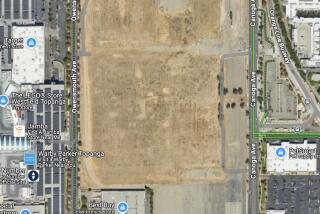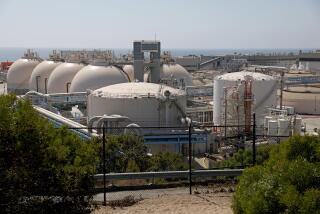Arms Race Leaves a Troubling Legacy of Liquid Nuclear Waste : Environment: Billions of gallons were dumped on the ground at a Washington plant. There is little firm knowledge about how extensive the problem is, or when it may pose a hazard to humans.
RICHLAND, Wash. — The volume of liquid wastes dumped from nuclear weapons production facilities at Hanford, Wash., once was thought to be enough to fill one-fifth of Seattle’s giant Kingdome stadium.
But now estimates are that the waste, some of it radioactive, would fill nearly 900 Kingdomes.
A U.S. Department of Energy report gave a new perspective to the job of cleaning up the environmental damage caused by the nuclear arms race.
The liquids were poured into the ground as workers rushed to make plutonium for nuclear weapons, mostly in the 1940s, ‘50s and ‘60s, when Hanford was arming many of the nation’s nuclear weapons. Some dumping continues to this day.
The Department of Energy in April disclosed that at least 444 billion gallons of waste was dumped into the soil, because there was no where else to put it.
The new figure dwarfed the previous estimate of 127 million gallons.
More than 80% of the liquid was uncontaminated water from the Columbia River, used to cool Hanford’s nine reactors. It did not pose a hazard to the public.
But up to 88 billion gallons was contaminated with a range of radioactive substances.
Since the 1940s, the most radioactive wastes have been stored in tanks, some of which have leaked. Because tank space was limited, the least radioactive liquids were dumped on the ground or poured into ponds.
Some of the radioactive materials last for millions of years, and are leaching through ground water into the nearby Columbia River, Hanford officials acknowledge.
They say that little is known about the contents of the waste or its true volume.
“The numbers are not totally accurate,” deputy Hanford manager Phil Hamric said. “Some may be off by 30% or so. But it’s the best we can do with old documents.”
Records on chemicals dumped into the soil were not kept until 1980, said Richard Wojtasek, manager of environmental restoration for Westinghouse Hanford Co., the federal contractor that runs the site.
The April report was the first effort to gather data on liquid wastes into one document, Hamric said. It was prompted after recent disclosures that the Energy Department in the past added cooling water to a storage tank that was known to be leaking. That tank, called 105-A, has leaked 50,000 to 800,000 gallons of highly radioactive liquid into the soil.
The report said:
* There are 619 locations at Hanford where radioactive liquids were discharged to the ground, totaling 678,000 curies of radioactivity.
* From 1946 to 1966, 121 million gallons of radioactive wastes from the storage tanks were dumped intentionally into the ground, totaling 65,100 curies. There have been no intentional discharges from the tanks since 1966.
* There are 66 storage tanks thought to have leaked, sending 750,000 gallons into the ground. That does not include tank 105-A.
* More than 99% of Hanford’s 5.6 million curies of radioactivity remains inside the 177 tanks, which hold 65 million gallons of liquid waste.
More to Read
Sign up for Essential California
The most important California stories and recommendations in your inbox every morning.
You may occasionally receive promotional content from the Los Angeles Times.










